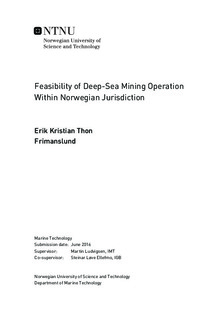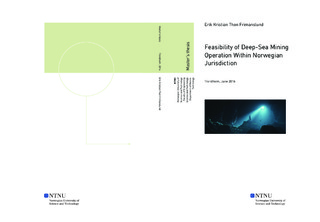| dc.description.abstract | Numerous hydrothermal vent sites are discovered along the Arctic Mid-Ocean Ridge (AMOR), stretching some 1,050 km from Jan Mayen to Svalbard, mostly within Norway s economically exclusive zone (EEZ). Associated with these are seafloor massive sulfide (SMS) deposits; ore containing valuable metals, such as copper, zinc, gold, and silver. Loki s Castle is one of the most promising sites along the AMOR, with a 20-30 m thick and 200 m wide SMS deposit. It is located within Norwegian jurisdiction at a water depth of 2,400 m. Based on a combined geotechnical and economic analysis in which metal grade distributions are modelled separately, 51,100 t copper, 55,600 t zinc, 1.72 t gold, and 86 t silver are found to be recoverable. A production system concept is proposed for a deep-sea mining operation at Loki s Castle, and is based on the system developed for Nautilus Minerals Solwara 1 project for the calm waters offshore Papua New Guinea. A combined bulk carrier and supply vessel handles transportation of ore, supplies and personnel. The production system design consists of: three remotely operated mining crawlers (Seafloor Production Tools, SPTs); a rigid riser system (Riser and Lifting System, RALS) with a suspended positive displacement pump (Subsea Slurry Lift Pump, SSLP); and a surface vessel (Production Support Vessel, PSV), at which the ore is dewatered and stored before being shipped to shore for further processing. Despite being the SSLP being limited to an H_s of 4-5 m and face design issues with respect to structural integrity in the harsh environment, the overall concept is regarded feasible. As the only relevant operational experience is De Beers shallow-water diamond mining off the coast of South Africa and Namibia, most of the environmental criteria used are taken from offshore drilling. With respect to flow restrictions, the production capacity is limited by the SSLP at 8,202 t/day (for 3.3 SG ore, 12 % ore-water slurry). Based on the net operating time, and accounting for scheduled maintenance and waiting-on-weather time, an annual average production rate of 3,591 t/day and an annual production volume of 1,309,917 t are found. Significant downtime is excepted in January and July due to periodic maintenance of the SSLP; a criticality for the production system s performance. At full production rate, the cargo holds of the PSV has a capacity of 8.2 days of ore (12 %), which governs the maximum round-trip time for the bulk/supply vessel, including handling times and contingencies.
Significant uncertainties are associated with the early phases of projects. Probabilistic cost estimates allow dealing quantitatively with uncertainties by giving input variables as probability distributions. A particular normal or lognormal distribution is established by assuming P_10 and P_90 values from which mean and standard deviation are calculated. Monte Carlo simulations are run for different sets of random variables, and outputs are given as distributions. The mean total development cost is 444.754 M USD; SPTs and RALS being one-third each. Operating costs at 643,049 USD/day are mainly driven by PSV time charter rate and operating costs. Uncertainties in the latter are mainly related to fuel and repair costs, in addition to ROV charter rates. At 50 % thrust utilization, the average fuel consumption is 103.6 m3/day. The project cash flow is only modelled for the recoverable copper equivalent; a weighted sum of the individual metals that are present in a deposit, when converted to copper value. After adjusting the production profile that is generated in GeoX (i.e., accumulating all tail production in the second year of production), a mean production period of 1.3 years is found. A typical SMS deposit is exploited in about 2-3 years. Three price scenarios for copper are defined based on forecasts towards 2025; low, mean, and high. When evaluating the expected free cash flow for both Norwegian ordinary corporate tax and the Norwegian petroleum tax scheme, positive net present value (NPV) is only obtained for the mean and high price scenarios for the petroleum tax scheme. The combined effect of CAPEX-heavy first years of cash flows and a 5-15-year lifetime of the production system are compensated for by a resale of the production system is included as a positive cash flow at the end of the production period. | |

